Physical Address
304 North Cardinal St.
Dorchester Center, MA 02124
The term acantholysis derives from the Greek akantha , a thorn or prickle, and lysis , a loosening. In its simplest definition, the term is used to reflect a primary disorder of the skin (and sometimes the mucous membranes) characterized by separation of the keratinocytes at their desmosomal junctions ( Fig. 5.1 ). A wide range of conditions are characterized by this feature, from inherited disorders such as Darier disease and Hailey-Hailey disease, in which a calcium pump gene mutation results in desmosomal instability, through to the autoimmune pemphigus group of diseases, whereby autoantibodies directly damage desmosomes with resultant keratinocyte separation and blister formation ( Table 5.1 ). Desmosomes may also be damaged by secondary phenomena, for example, following severe edema, either intercellular (spongiosis) or intracellular (e.g., ballooning degeneration as is seen in various viral infections). Such processes, however, are not included in the acantholytic category and are discussed elsewhere. The histologic features of the conditions described in this chapter show considerable overlap. The diagnosis is therefore dependent on adequate clinical information and the results of immunofluorescence investigations.
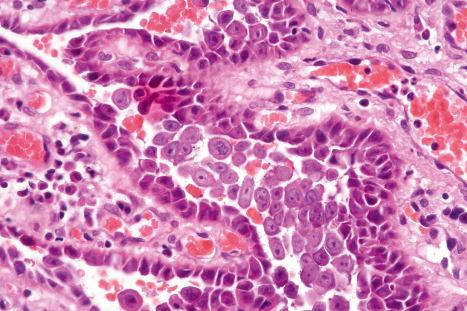
| Pemphigus variant | Autoantigen |
|---|---|
| Pemphigus vulgaris | Dsg3 (mucosal), Dsg1 (cutaneous), desmocollins, pemphaxin, α9-acetylcholine receptor |
| Pemphigus vegetans | Dsg3, Dsc1, and Dsc2 in some patients |
| Pemphigus foliaceus | Dsg1 |
| Pemphigus erythematosus | Dsg1 |
| Fogo selvagem | Dsg1, rarely also Dsg3 |
| IgA pemphigus | Dsc1, Dsg1 or Dsg3 |
| Herpetiform pemphigus | Dsg1, rarely also Dsg3 |
| Paraneoplastic pemphigus | Desmoplakins I and II, envoplakin, periplakin, BP230, plectin, Dsg1, and Dsg3 |
| Drug-induced pemphigus | Dsg1 or Dsg3 |
Pemphigus (Gr. pemphix , blister) refers to a group of chronic blistering diseases which develop as a consequence of autoantibodies directed against a variety of desmosomal proteins. The condition as a whole is rare, with an annual incidence ranging from 0.1 to 0.7 per 100 000 of the general population. It is more common in the Jewish population, in which the annual incidence rises to 1.6–3.2 per 100 000. Ashkenazi Jews are the most frequently affected. The incidence in India also appears to be higher than in other countries. There is no sex predilection.
The clinical features and, therefore, classification of these disorders depend on the level of separation within the epidermis:
In pemphigus vulgaris (p. vulgaris) and pemphigus vegetans (p. vegetans), the blisters are suprabasal.
In pemphigus foliaceus (p. foliaceus), pemphigus erythematosus (p. erythematosus), and fogo selvagem, the blisters are situated more superficially.
P. vulgaris is by far the most common variant, accounting for 80% of cases.
In addition to affecting humans, pemphigus has been described in a variety of animals including dogs, cats, goats, and horses.
P. vulgaris particularly affects the middle-aged (onset typically at 40–60 years of age), although occasionally (up to 2.6%) children are affected. Self-limiting neonatal disease through transplacental transfer of maternal autoantibodies has also rarely been documented (see pathogenesis). The disease begins in the mouth ( Figs 5.2 and 5.3 ) in 50–70% of patients with painful erosions or bullae and, after a period of weeks or months, the blisters spread to involve the skin. Oral lesions most commonly affect the buccal, palatine, and gingival mucosae. P. vulgaris is only rarely confined to the skin.
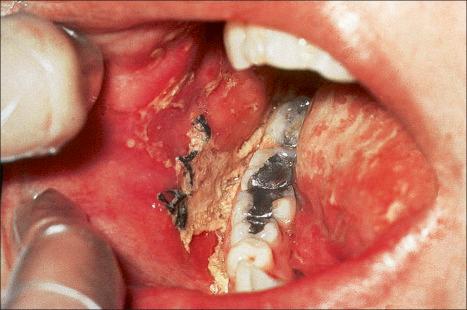
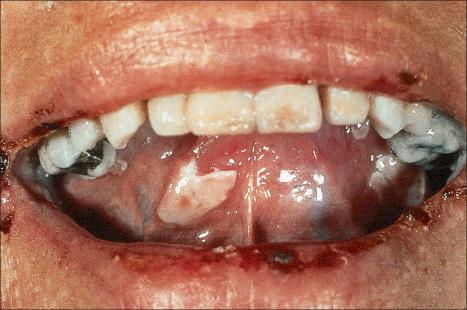
The typical skin lesion is a fragile, flaccid blister, which develops on normal or erythematous skin, and readily ruptures, leaving a painful, crusted, raw, bloody erosion ( Figs 5.4 and 5.5 ). Lesions are most often seen on the scalp, face, axillae, and groin, although in some patients they are generalized ( Figs 5.6–5.8 ). Blisters can be induced by rubbing the adjacent, apparently normal skin – the Nikolsky sign. Direct pressure applied to the center of the blister is also followed by lateral extension – the Asboe-Hansen sign. Healing is often accompanied by postinflammatory hyperpigmentation but scarring is not a feature.
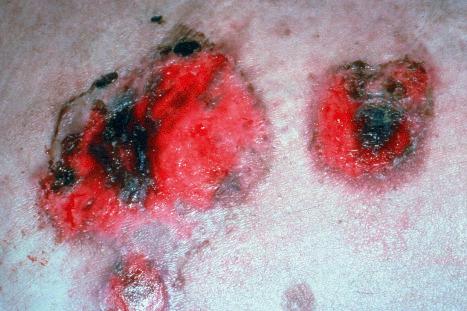
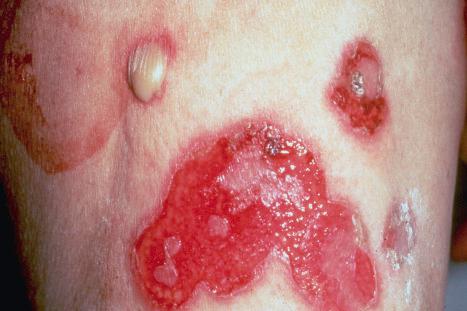
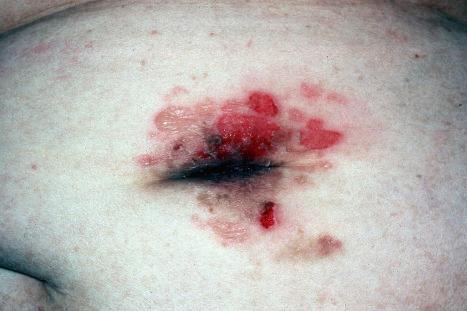
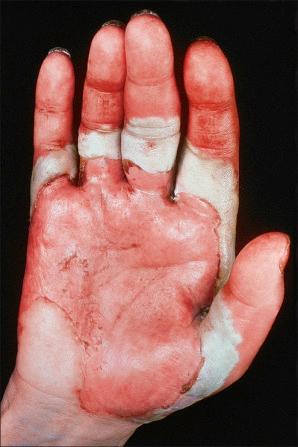
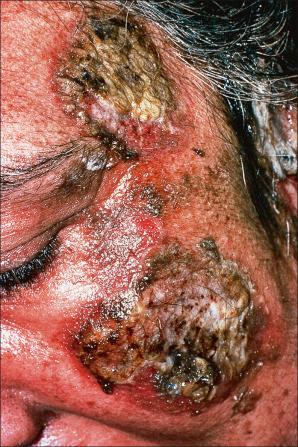
Before the introduction of corticosteroid therapy, the lesions usually became more extensive and in the past often led eventually to death. Treatment with high doses of corticosteroids, immunosuppressants (such as azathioprine), intravenous immunoglobulins, and, more recently, biologicals (such as rituximab) has significantly reduced the mortality to 5–15%, and prolonged remissions without treatment are now being reported. A considerable proportion of the deaths that do occur, however, are due to the side effects of therapy and include staphylococcal infections and, to a lesser extent, pulmonary embolism. Severe opportunistic infections due to a wide range of organisms including listeria, nocardia, enterococci, herpes virus, cryptococcus, and candida may further complicate the disease. Patients may also suffer from Cushing syndrome, adrenal insufficiency, and myasthenia gravis, and appear to have a slightly increased risk of leukemia and non-Hodgkin lymphoma.
Nail involvement seems to be more common than previously reported and may precede skin findings. Patients may present with hemorrhagic paronychia, chronic paronychia, trachyonychia, onycholysis, or onychomadesis. Paronychia and onychomadesis are the most common nail changes encountered. Nail involvement is more common in the nails of digits affected by periungual blisters and also in patients with large number of skin blisters.
Occasional modes of presentation include linear lesions and pemphigus arising after surgery, burns, vaccination, radiation therapy, and trauma. Development after exposure to pesticides and an association with cocaine snorting has also been reported. A very exceptional case has been described in which blisters were initially confined to melanocytic nevi. P. vulgaris may also be rarely induced by a variety of drugs, particularly angiotensin-converting enzyme (ACE) inhibitors such as captopril.
In addition to oral and cutaneous involvement, lesions have been described at a wide variety of sites including the nasopharynx, larynx, ear, esophagus, eye, external genitalia, urethra, and anal and colonic mucosa. Esophageal lesions, although originally thought to be rare, have been documented in as many as 63–87% of patients. Erosions and ulcers are typically found, and intact blisters are rare. Exceptionally, the whole mucosa may be affected with subsequent sloughing – esophagitis dissecans superficialis. Ocular involvement appears to be more common than previously thought, involving up to 26% of patients. Ocular lesions are usually restricted to the conjunctiva, presenting as conjunctivitis or small vesicles that rapidly rupture. Very rarely, scarring may develop, and corneal ulceration with perforation has been described. Vulval, vaginal, and cervical lesions are well recognized and common. Exceptionally, the vagina may be the sole site of involvement. Penile lesions most commonly affect the glans. They are not usually followed by any significant sequelae.
The development of pemphigus may be associated with a variety of disorders (primarily other autoimmune diseases), including bullous pemphigoid, lupus erythematosus, myasthenia gravis, Hashimoto thyroiditis, vitiligo, minimal change nephropathy, ulcerative colitis, rheumatoid arthritis, and diabetes mellitus. It has also been described in a patient with the 1p36 deletion syndrome. As in many other diseases with an immunological pathogenesis, pemphigus is accompanied by an increased incidence of internal malignancy including thymoma, lymphoma, and multiple myeloma (see paraneoplastic pemphigus). It has also been reported in association with Kaposi sarcoma.
Pemphigus is an immunologically mediated disease. The most reliable method to confirm the diagnosis is by direct immunofluorescence. The later is more accurate than serological methods. Examination of perilesional skin by direct immunofluorescent techniques reveals in vivo-bound immunoglobulin (usually IgG) and often complement (C3) in the intercellular region of the epidermis ( Fig. 5.9 ). Abundant antigen in the follicular outer root sheath and germinal matrix may account for the marked scalp involvement typical of pemphigus, and plucked hair follicles may serve as an adequate substrate for direct immunofluorescence analysis. The in vivo-bound IgG is mainly of the IgG1 and IgG4 subclasses.
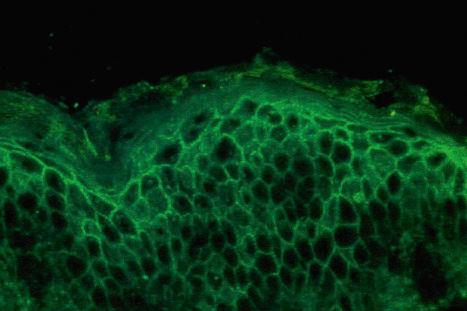
Indirect immunofluorescent techniques show that the serum of patients with pemphigus contains an IgG antibody that reacts with the intercellular region of normal squamous epithelium. This antibody is, however, not entirely specific as it may be found in a variety of other conditions, such as severe burns and penicillin drug reactions, and following radiation therapy. Presumably, pemphigus antigens are released into the circulation following such trauma with resultant antibody production. Circulating antibodies are predominantly of the IgG1 and IgG4 subclasses; IgG3 is identified much less often.
Circulating IgG is pathogenic. The level of the antibody titer closely parallels the clinical state of the disease. IgG4 titers diminish during remission whereas circulating IgG1 may continue to be present. Relapse is commonly preceded by rising IgG4 antibody titers.
As mentioned above, p. vulgaris rarely may be evident in a neonate born of a mother with active p. vulgaris due to passive transfer of autoantibodies across the placenta. The condition is, however, short lived, with lesions disappearing, as the maternal antibodies are catabolized. Passive transfer of IgG4 into neonatal mice results in the development of blisters. Purified IgG from pemphigus induces acantholysis in human skin explants and keratinocyte cultures.
The pemphigus antibody binds to the full thickness of the epidermis. Compared with p. vulgaris, immunofluorescence studies on the sera of p. foliaceus patients tend to show more staining in the superficial epidermis, correlating with the level of the split. Conversely, the sera from patients with p. vulgaris show more affinity for the lower epidermis. Despite these trends, we do not base diagnoses on these (often subtle) differences in immunofluorescence staining distribution.
The p. vulgaris antibody is directed at the extracytoplasmic domain of the 130-kD epithelial desmosomal cadherin, desmoglein 3 (Dsg3), which forms a complex with plakoglobin (85 kD). The p. vulgaris antibody, however, does not recognize the latter. Many patients also have antibodies that bind to the p. foliaceus antigen, desmoglein 1 (Dsg1), a 160-kD polypeptide. Dsg3 is expressed primarily in the oral mucosa and, therefore, antibodies directed against this antigen result in mucosal pemphigus. In contrast, Dsg1 is a cutaneous antigen and, therefore, antibodies directed against it result in lesions affecting the skin but not the mucosa (cutaneous pemphigus). Anti-Dsg1 antibodies also show cross-reactivity against Dsg4, another member of the desmoglein family. While patient sera contain antibodies against nonconformational epitopes of Dsg3, active disease correlates with the presence of antibodies directed against the NH2-terminal aspect of Dsg3, in particular ectodomains 2–4. Oral disease is particularly associated with reactivity to ectodomains 1–4, which is reduced in cutaneous pemphigus.
Antibodies reactive to a number of other proteins including desmoplakin, desmocollins, pemphaxin, and acetylcholine receptor have also been demonstrated in the sera of p. vulgaris patients.
Sera from patients with p. vulgaris not infrequently contain additional IgA antibodies, in particular against Dsg1 and Dsg3. Although the combination of both IgG and IgA antibodies has, in some instances, been referred to as IgG/IgA pemphigus in the literature, this appears to be an ill-defined and heterogeneous disease group. In addition to p. vulgaris, the additional presence of anti-Dsg IgA antibodies has also been demonstrated in p. foliaceus, p. vegetans, pemphigus herpetiformis, and paraneoplastic pemphigus. Although there is some doubt that this is a truly distinct entity, the so-called IgG/IgA pemphigus may show an atypical clinical presentation with pustules, annular lesions, or a malar rash. Most do not have mucosal involvement. Association with malignancy has been suggested. Histologic features may be more reminiscent of IgA pemphigus, and the presence of IgA antibodies against desmocollins is seen in a subset of patients.
The pathogenesis of the acantholysis is uncertain. Direct binding of antibody to the desmosomal cadherins is of major importance and results in internalization of Dsg3 and degradation by the endolysosomal pathway. Plakoglobin has been implicated in mediating intracellular events following IgG binding to Dsg3. In particular, the role of plakoglobin is signal transduction to the nucleus. There is also some evidence to suggest that the process may involve, at least secondarily, the action of local proteolytic enzymes. The pemphigus antibody induces expression of plasminogen activator receptor on the surface of keratinocytes. Binding of plasminogen activator to its keratinocyte cell membrane receptor results in plasminogen activation with resultant production of plasmin. This latter has non-specific proteolytic activity, which may be responsible at least in part for the dissolution of the desmosomes. P. vulgaris antibodies stimulate production of keratinocyte phospholipase C and inositol 1,4,5-triphosphate and increase intracellular calcium. Protein kinase C activation results in release of keratinocyte plasminogen activator and increased expression of plasminogen activator receptor. Other factors, however, must be of greater importance since p. vulgaris IgG can induce acantholysis in plasminogen activator knockout mice. An additional phenomenon is rapid phosphorylation of heat shock protein 27 and p38MAPK, resulting in reorganization and collapse of the cytoskeleton as a result of IgG binding to Dsg3. This process is mediated by upstream events involving EGF receptor kinase and Src. Complement appears not to be essential for acantholysis, and it is thought that any involvement is secondary, perhaps accelerating or extending the process. It has been suggested that apoptosis may be induced by p. vulgaris IgG, and that this mechanism may be important in the pathogenesis of the disease. Other studies have shown that apoptosis is not a prerequisite for blistering and may be a secondary phenomenon. Apoptolysis is a process whereby the autoantibodies activate the apoptotic pathway through EGFR/Src signaling through mTOR, resulting in basal cell shrinkage rather than complete apoptosis with subsequent acantholysis.
T cells are also critical to the development of the antibody-mediated acantholysis. CD4+ memory T cells are predominantly involved and both T-helper 1 (Th1) and Th2 Dsg3-specific subtypes are represented. Th1 T cell-derived interferon-γ stimulates production of IgG1, and Th2 cells produce interleukin (IL)-4 and IL-13, which are responsible for secretion of B cell-derived IgG4. Both populations are therefore of importance in stimulating production of p. vulgaris antibody. In addition, there is evidence that tumor necrosis factor 1 (TNF-1), Fas-ligand, and IL-1 are also of importance in the development of acantholysis. Knockout mice for both these cytokines show diminished acantholysis in passive antibody transfer experiments.
There is considerable evidence of a genetic background influencing susceptibility to pemphigus as shown by strong associations with human leukocyte antigen (HLA)-DRβ1*0402, HLA-DRβ1*1401, and HLA-DQβ1*0503. Perhaps surprisingly, however, there are only occasional documented reports of familial occurrence.
Pemphigus blisters rupture easily. It is therefore essential to biopsy an early lesion to establish the correct diagnosis. 186a The characteristic acantholysis develops because of damage to the intercellular bridges. Acantholytic cells are rounded and have intensely eosinophilic cytoplasm, pyknotic nuclei, and perinuclear halos. An early lesion of p. vulgaris shows a slitlike suprabasal cleft or vesicle containing occasional acantholytic cells. The established blister contains acantholytic cells in clumps and in isolation ( Figs 5.10 and 5.11 ). Characteristically, the floor of the cavity is lined by a single layer of intact basal cells, the so-called ‘tombstone’ pattern ( Fig. 5.12 ). The acantholytic process frequently involves the epithelium of the adnexae, which can be a useful diagnostic clue in those lesions which lack the roof of the blister ( Fig. 5.13 ). Acantholytic changes are also seen in epidermoid cysts. The dermal papillary outline is usually maintained, and frequently, the papillae protrude into the blister cavity. Sometimes the features of eosinophilic spongiosis are seen on biopsy, particularly in early lesions. The blister cavity often contains a few inflammatory cells (notably eosinophils), and in the dermis, there is a moderate perivascular chronic inflammatory cell infiltrate with conspicuous eosinophils, although sometimes these are scanty or even absent. Mucous membrane lesions show similar histology.
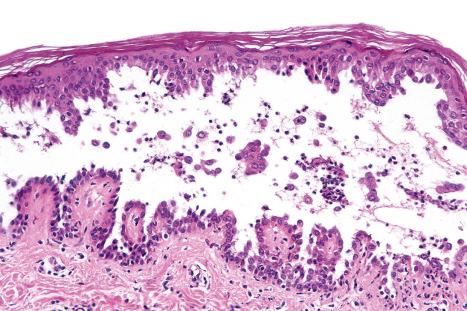
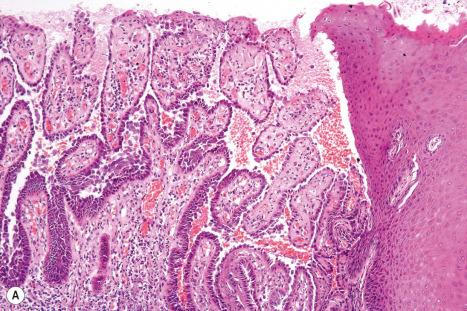
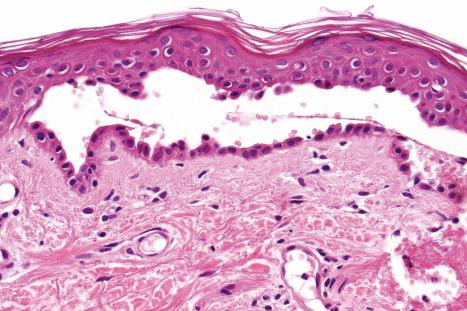
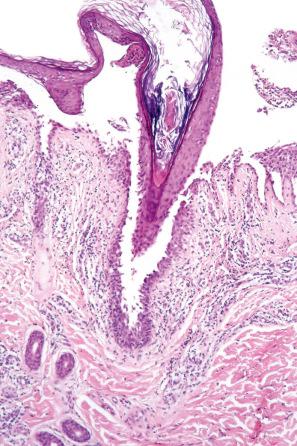
The histologic features can in part be explained by the compensation theory. This theory suggests that one Dsg type may be sufficient to maintain epithelium integrity by compensating for the loss of the specific Dsg targeted. In mucosal predominant pemphigus, the autoantibodies target Dsg3, and the relative lack of Dsg1 in mucosa explains the prominent acantholysis in the mucosa and relative sparing of the epidermis. The presence of Dsg1 compensates for the loss of Dsg3 in the skin. In p. foliaceus (see below), the primary target is Dsg1, which is primarily found in the upper epidermis. This explains the superficial nature of the split and sparing of the mucosa, which lacks significant Dsg1.
Ultrastructurally, there is dilatation of the intercellular space with consequent stretching of the desmosomal attachment points ( Figs 5.14 and 5.15 ). With progression, these separate and eventually disappear, with residual cell membranes often showing a pseudovillous morphology. Hemidesmosomes are morphologically normal. Immunoelectron microscopy confirms that the immunoreactants are located within the intercellular space.
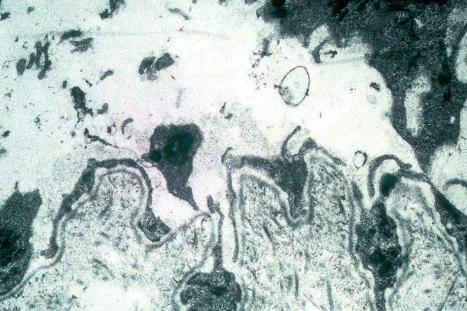
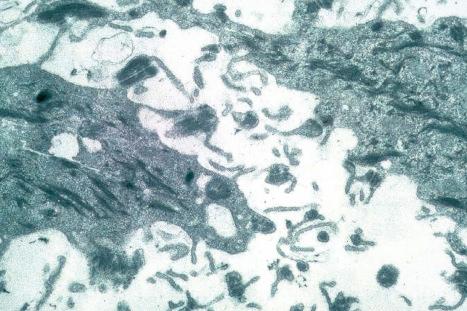
Patients with clinical and histologic presentation of p. vulgaris but epidemiological features of fogo selvagem were identified in the Goiania and Brasilia regions of Brazil, known endemic areas of p. foliaceus. These patients demonstrate classical mucocutaneous disease and antibodies to both Dsg1 and Dsg3, but are remarkable for early onset of disease, frequently before the age of 20.
The differential diagnosis of p. vulgaris includes a variety of conditions such as Darier disease, Hailey-Hailey disease, and transient acantholytic dermatosis (Grovers disease) ( Table 5.2 ). In the absence of clinical information or without immunofluorescence studies, it may be impossible to establish a definitive diagnosis. None of these diseases has a specific pattern of immunoreactivity on direct immunofluorescence.
| Pemphigus vulgaris a | Darier disease a | Hailey-Hailey disease a | |
|---|---|---|---|
| Types of lesion | Intraepithelial bullae | Suprabasal clefts | Intraepithelial bullae |
| Adjacent epithelium | Intact | Intact | Disintegrating |
| Involvement of adnexae | Yes | Yes | No |
| Corps ronds and grains | No | Yes | Rarely |
| Dermal inflammation | Mononuclears, eosinophils | Mononuclears | Mononuclears |
| IMF | Positive | Negative | Negative |
a The lesions of Grover disease may histologically mimic any of these and can only be distinguished with appropriate clinicopathologic correlation and/or by immunofluorescence.
Dyskeratosis in the form of corps ronds and grains is typical of Darier disease, but is rarely seen in Hailey-Hailey disease, and is not a feature of pemphigus. In Hailey-Hailey disease, the perivesicular epithelium is likened to a dilapidated brick wall, an effect sometimes seen in p. vulgaris. More frequently, however, the epithelium overlying and adjacent to the blister is essentially intact.
Acantholysis involving the follicular epithelium is often seen in pemphigus, but usually not in Hailey-Hailey disease. The pemphigus-like variant of Grover disease is histologically indistinguishable from pemphigus, but the clinical history, minute size of the lesions as viewed by the microscope, and negative immunofluorescence findings make distinction relatively easy. Extreme degrees of acantholysis in acantholytic solar keratosis may on rare occasions be confused with the previously mentioned acantholytic disorders. Similarly, it is important not to misinterpret the trivial finding of incidental focal acantholytic dyskeratosis in a skin specimen removed or biopsied for an unrelated finding.
P. vegetans, a chronic variant of p. vulgaris, has a somewhat better prognosis than p. vulgaris with occasional cases associated with spontaneous remission documented. It accounts for 1–9% of all cases of pemphigus and appears to be especially common in North Africa. As with the vulgaris variant, p. vegetans typically presents in adults. There has, however, been a small number of cases described in childhood including a dapsone-responsive IgA-mediated variant. The lesions, which present as blisters and erosions, are particularly prolific in the flexures, especially the axillae, the groin, the inframammary region, the umbilicus, and at the margins of the lips. The scalp is also said to be a site of predilection. Soon thereafter, patients characteristically develop hypertrophic vegetations and pustules at the blistered edges ( Fig. 5.16 ).
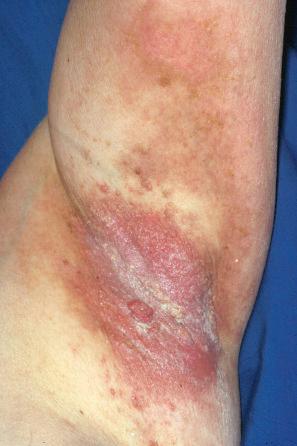
The oral cavity is commonly affected, and a cerebriform or ‘scrotal’ tongue is said to be a diagnostic clue in cases of early involvement. An exceptional case of the disease restricted to the tongue has been reported. Esophageal involvement presenting as erosions and white plaques has been described in a number of patients, and the nasal mucosa, larynx, vulva, vagina, penis, and anus may also be affected. Nail involvement including onycholysis and pustules is sometimes seen. Acral involvement can clinically be mistaken for acrodermatitis continua suppurativa. Peripheral blood eosinophilia is commonly present.
Two clinical subtypes are recognized:
In the Neumann variant (the more serious form), lesions usually begin as described in p. vulgaris, but the ensuing erosions develop vegetations. The course of this variant is similar to that of p. vulgaris.
In the Hallopeau variant (‘pyodermite vegetante’), the eruption begins as pustular lesions that rapidly evolve into verrucous vegetating plaques. Bullae are usually not seen. This is a milder variant in which spontaneous remission is not uncommon.
Support for the thesis that p. vegetans is a variant of p. vulgaris is based on the finding that both subtypes are associated with IgG and C3 deposition in the epidermal intercellular space on direct immunofluorescence, and circulating ‘pemphigus’ antibody. P. vegetans is characterized by an antibody directed at the Dsg3. Antibodies against desmocollins 1 and 2 as well as periplakin have also been documented. Rarely, additional IgA antibodies to Dsg3 may also be detected.
Precipitating factors for this pemphigus variant are largely unknown. A case has been described developing after and restricted to a split-thickness skin graft. Exceptionally p. vegetans has been linked with the ACE inhibitors captopril and enalapril. Further exceptional cases developed in association with intranasal heroin or cocaine abuse and HIV infection. There are rare reports relating a p. vegetans-like lesion as a manifestation of paraneoplastic pemphigus and p. vegetans with underlying malignancy.
Although a variant of p. vulgaris, p. vegetans shows strikingly different histologic features. Suprabasal acantholysis is present but is often subtle, being masked by an exuberant proliferation of squamous epithelium, which may sometimes show pseudoepitheliomatous hyperplasia ( Fig. 5.17 ). The epithelial proliferation involves both the epidermis and the infundibular follicular epithelium. Characteristically, there is an intense inflammatory cell infiltrate containing numerous eosinophils, and intraepidermal microabscesses are often seen ( Figs 5.18 and 5.19 ). Eosinophilic spongiosis is often a prominent feature. The inflammatory changes and epithelial proliferation are sometimes so marked that the true nature of the lesions is obscured. Very occasionally, 10–40-µm eosinophilic hexagonal Charcot-Leyden crystals have been described within the eosinophil-rich microabscesses. The diagnosis of p. vegetans is easily overlooked and is made only by the pathologist with a high index of suspicion.
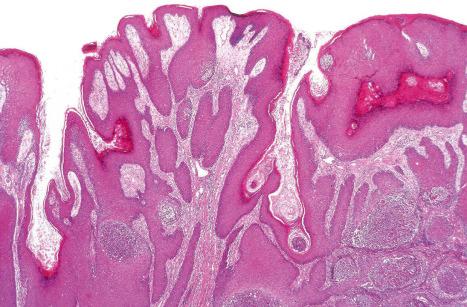
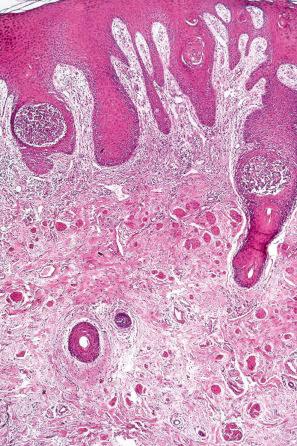
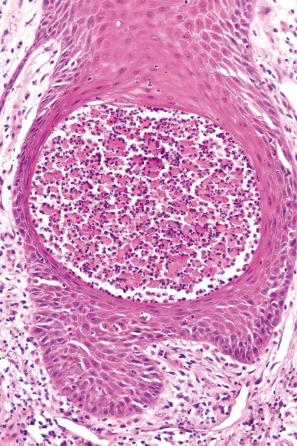
Given the histologic overlap with p. vulgaris, the same differential diagnosis as discussed for that variant should be considered. In established lesions associated with squamous epithelial hyperplasia, the suprabasal cleft formation is often focal and easily overlooked. Infections, particularly fungal and bacterial, that are associated with pseudoepitheliomatous hyperplasia and microabscesses may be confused with p. vegetans. In particular, pyostomatitis/pyodermatitis vegetans must be excluded in patients presenting with oral involvement. The latter is usually associated with inflammatory bowel disease, and although it may mimic p. vegetans clinically and histologically (acantholysis tends to be focal and is often absent in pyostomatitis), direct immunofluorescence is usually negative. In rare cases however, in pyostomatitis/pyodermitis vegetans direct immunofluorescence may be positive for IgA in the superficial epidermis and/or for IgG and C3 at the dermoepidermal junction. In exceptional cases there seems to be overlap between these conditions and pemphigus. Halogenoderma (iododerma and bromoderma) may also show similar histological features with prominent eosinophilic spongiosis but in the latter acantholysis is not a feature.
P. foliaceus is considerably more uncommon than p. vulgaris, and although it most often affects the middle-aged and elderly, it has a very variable age of onset, sometimes affecting younger adults and even, occasionally, children. Very exceptionally, maternal antibodies have been known to cross the placenta, resulting in neonatal disease. In general, nonendemic p. foliaceus in children is relatively benign and of short duration.
The superficial blisters of p. foliaceus are exceedingly fragile and therefore much less obvious; erosions and large leafy scales or crusts are often predominant ( Figs 5.20–5.22 ). The lesions may remain localized to the scalp, nose, face, and trunk for many months or years, leading to a mistaken diagnosis of seborrheic dermatitis, seborrheic keratosis, or even lupus erythematosus. Sometimes the eruption involves the entire surface of the body or produces a clinical resemblance to exfoliative dermatitis (erythroderma) ( Fig. 5.23 ). Mucous membrane involvement is rare due to the lack of Dsg1 in oral mucosa (see below). Exceptionally, patients may present with localized disease, typically restricted to the face. The development of pustular lesions is exceptional. P. foliaceus often has a much more benign course than p. vulgaris, although patients with severe disease, requiring corticosteroid and immunosuppressant therapy, still have a risk of mortality. The disease may be complicated by Kaposi varicelliform eruption, a disseminated eruption caused by a viral infection (e.g., herpes simplex virus) superimposed on a pre-existing dermatosis.
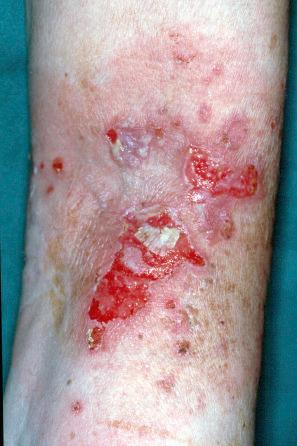
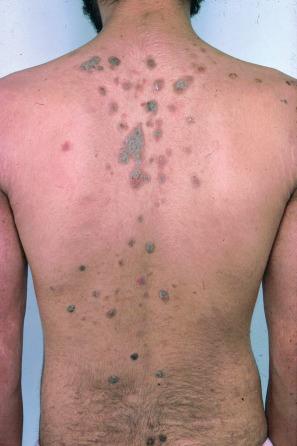
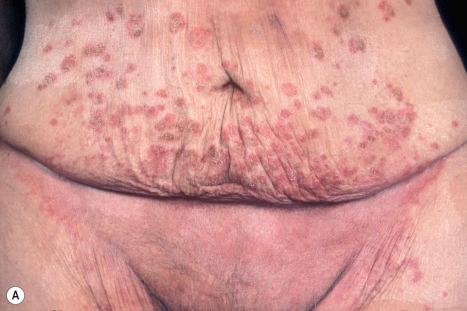
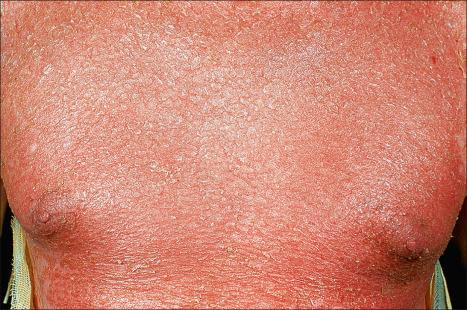
Very occasionally, patients may develop p. foliaceus during or after a previous episode of p. vulgaris and vice versa. The development of bullous pemphigoid following an episode of p. foliaceus has also been described. This is accompanied by an antigen shift, possibly as a result of intermolecular epitope spreading. A case of a blistering disorder displaying features of bullous pemphigoid and p. foliaceus has been described in association with consumption of Spirulina algae. The coexistence of both p. vulgaris and p. foliaceus in the same patient has also been reported. A further case of paraneoplastic pemphigus with concomitant clinical features of p. foliaceus and the presence of antibodies against desmoglein 1 has been reported.
In addition to idiopathic p. foliaceus, drug-induced variants, notably due to penicillamine, may also be encountered ( Fig. 5.24 ). A localized form may also be associated with topical drugs such as imiquimod and has been reported following radiation therapy. Recently, p. foliaceus related to an anti-TNF-α inhibitor has been reported. P. foliaceus is rarely associated with an underlying malignancy including non-Hodgkin lymphoma and esophageal cancer. An unusual case of p. foliaceus associated with myasthenia gravis and lupus erythematosus has been reported in a patient who underwent a thymectomy for a thymoma.
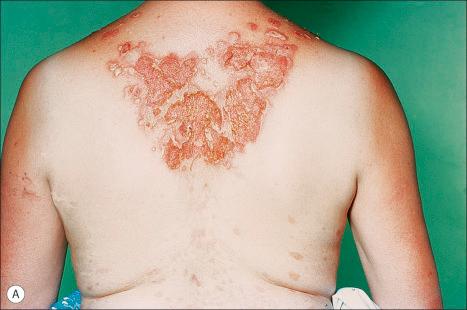
Similar to other variants of pemphigus, p. foliaceus is an immunologically mediated disease. Examination of perilesional skin by direct immunofluorescent techniques reveals in vivo-bound immunoglobulin (usually IgG) and often complement (C3) in the intercellular region of the epidermis. Abundant antigen in the follicular outer root sheath and germinal matrix may account for the marked scalp involvement typical of pemphigus.
Indirect immunofluorescent techniques show that the sera of patients with p. foliaceus contain an IgG antibody that reacts with the intercellular region of normal squamous epithelium. IgG4 predominates followed by IgG1. IgG3 is also sometimes present. This may be of importance since IgG3 is the most efficient activator of complement. Some 60–70% of patients have positive indirect immunofluorescence.
The p. foliaceus antibody binds to a 160-kD desmosomal cadherin, designated Dsg1. The sera of p. foliaceus patients bind to the extracellular amino terminal domain of bovine Dsg1, whereas sera from both p. vulgaris and p. vegetans patients react with the intracellular domain of Dsg1. Compared with p. vulgaris, immunofluorescence studies on the sera of p. foliaceus tend to show more staining in the superficial epidermis, correlating with the level of the split. Conversely, the sera from patients with p. vulgaris show more affinity for the lower epidermis. Anti-Dsg1 antibody is pathogenic. Injection of purified anti-Dsg1 antibodies from sera of patients with p. foliaceus into neonatal mice induces subcorneal acantholysis in a pattern typical of p. foliaceus. Acantholysis is thought to be the result of an antibody-mediated cellular response rather than purely the result of steric hindrance. Internalization of nonclustered Dsg1 has been put forward as a possible mechanism resulting in lack of newly formed desmosomes rather than a disruption of pre-existing structures. Increasing evidence suggests that the blistering is the result of the activation of p38 mitogen-activated protein kinase-dependent signaling by the p. foliaceus IgG antibodies. Rarely, patient sera contain additional IgG antibodies directed against Dsg3 and the presence of additional IgA antibodies against Dsg1 as well as Dsg3 has also been detected. Antibodies to desmocollins may also play a role, and at least one case of childhood p. foliaceus secondary to autoantibodies exclusively directed against desmocollins has been described. Patients with clinical and histologic features of p. foliaceus but direct immunofluorescence findings reminiscent of p. erythematosus have been reported. Antibodies recognizing bullous pemphigoid antigen 1 (BP230) as well as a 190-kD protein co-migrating with periplakin were detected in these patients in addition to anti-Dsg1 antibodies. The use of d -penicillamine may be associated with the acquisition of a pemphigus-like antibody and the development of p. foliaceus.
Since the blisters of p. foliaceus are superficial, they are therefore fragile, and it is often very difficult to obtain an intact lesion for diagnosis. Patients commonly have erosions without blisters, and frequently the clinician does not suspect a bullous disorder. Usually, the cleft or blister lies within the upper epidermis ( Fig. 5.25 ) but may also occur in the granular layer or throughout the epidermis. The roof of the fragile blister is often not present, having sloughed either before or after biopsy. Acantholysis is frequently difficult to detect, but usually a few acantholytic cells can be found attached to the roof or floor of the blister. In cases where the blister is missing, a careful inspection of the hair follicles may reveal focal acantholysis. In some cases, the acantholysis is subtle, and the biopsy may show features reminiscent of a spongiotic dermatitis ( Fig. 5.26 ) . Sometimes the blister contains numerous acute inflammatory cells ( Fig. 5.27 ), particularly neutrophils, which can make distinction from subcorneal pustular disorders, including bullous impetigo, a dermatophyte infection, candidiasis, pustular psoriasis, and subcorneal pustular dermatosis especially difficult. Eosinophilic spongiosis may also be seen. A form with histologic and clinical overlap with psoriasis has also been described.
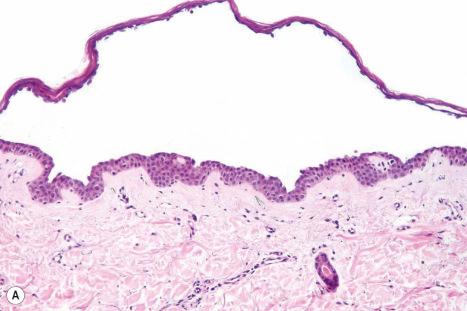
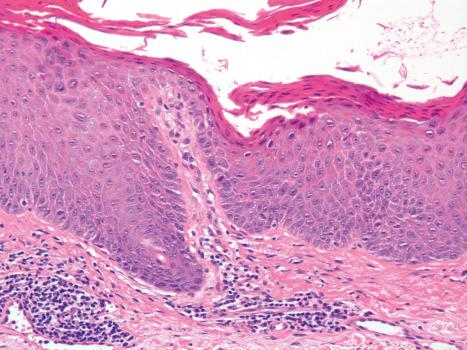
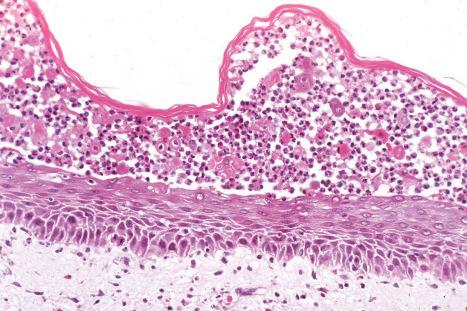
The histologic features in the superficial forms of pemphigus may be easily overlooked and, since bullae are often not appreciated by the clinician, the unwary pathologist may not consider a bullous disorder when evaluating the biopsy. A high index of suspicion is therefore critical. The differential diagnosis of superficial pemphigus includes bullous impetigo, staphylococcal scalded skin syndrome, IgA pemphigus, subcorneal pustular dermatosis, and psoriasis ( Table 5.3 ). Distinction depends on a careful consideration of the clinical information, the results of bacterial culture, and immunofluorescent studies.
|
Fogo selvagem (Brazilian p. foliaceus, ‘wild fire’, endemic p. foliaceus) is endemic in regions of Brazil and has also been documented in other areas of Central and South America including Colombia, El Salvador, Paraguay, Venezuela, and Peru. An endemic area has also been described in Tunisia. The condition is associated with poverty and malnutrition and particularly affects children and young adults. Results from a more recent epidemiological study demonstrated disease manifestation also in patients of higher socioeconomic class and urban areas. There is a striking familial incidence. Most cases are found along major rivers, and people especially at risk include farmers and workers involved in land clearing and road construction. It appears that the majority of patients live at an altitude of between 500 and 800 meters, and that their homes are generally within 10–15 kilometers of running fresh water and in the path of prevailing winds, thus suggesting an insect vector. In support of this, a case-controlled epidemiological study has provided evidence that bites by the black fly (family Simuliidae) are a significant risk factor for development of the disease, and it has been proposed that a component of the saliva may trigger an antibody response in susceptible individuals. Simulium nigrimanum , which is found in the same areas in which Brazilian fogo selvagem occurs, has been identified as being the likely species involved.
The clinical presentation of fogo selvagem has been divided into a number of categories including localized and generalized forms :
Localized disease presents in a variety of ways including small blisters and erosions or violaceous papules and plaques distributed mainly in the seborrheic areas. Such lesions may be clinically misdiagnosed as discoid lupus erythematosus.
Generalized presentation includes bullous exfoliative, exfoliative erythrodermic, and disseminated plaque and nodular (resembling nodular prurigo) variants ( Fig. 5.28 ).
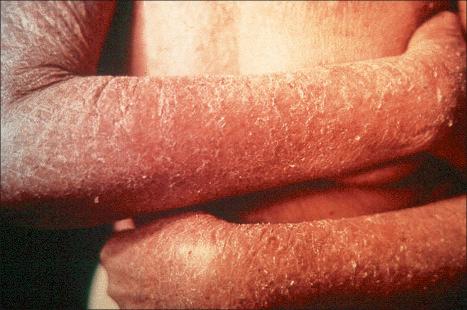
With resolution, patients may sometimes develop hyperpigmentation. Rare cases of neonatal p. foliaceus have been reported, but in most patients the antibody does not cross the placental barrier. Patients with fogo selvagem appear to rarely have other concomitant autoimmune disorders.
In contrast to Brazilian fogo selvagem, endemic disease in the area of El Bagre, Colombia, shows several unusual and distinguishing features. The disease affects an older population with a strong male predilection and clinical features reminiscent of p. erythematosus. In addition to the more classical presentation, patients develop hyperkeratotic plaques on the face, chest, and back reminiscent of discoid lupus erythematosus as well as an erythematous macular lesion in a butterfly-like distribution in the central face. Active disease is also accompanied by conjunctivitis. The disease also shows characteristic immunological and histologic changes, which are discussed below.
The immunological features of fogo selvagem are similar to p. foliaceus. Indirect immunofluorescent techniques show that the sera of patients with fogo selvagem contain an IgG4 antibody that reacts with Dsg1. Passive transfer of this antibody to BALB/c neonatal mice results in acantholysis and subcorneal blistering clinically indistinguishable from that of human disease. Low-titer IgG1 and IgG2 antibodies may also be present, and nonpathogenic IgG1 antibodies are present in unaffected individuals and in the preclinical stages of patients from endemic areas. IgG antibodies may be accompanied by IgM antibodies, a finding seen more frequently in individuals from rural rather than urban areas. IgM and IgE antibodies are detected more frequently associated with fogo selvagem than p. foliaceus. Fogo selvagem is otherwise histologically and by immunofluorescence indistinguishable from nonendemic foliaceus and, like the latter, the antibody recognizes epitopes in the ectodomain of Dsg1. Epitope recognition is conformation specific and calcium dependent, and recently intramolecular epitope spreading has been implicated in the pathogenesis of the disease. Epitope spreading appears to be related to onset of disease as well as disease modulation with remission and relapse. Specifically, it has been shown that sera from patients in the preclinical stage or in remission recognize epitopes in the COOH-terminal region of the ectodomain of Dsg1, whereas antibodies against epitopes in the NH 2 -terminal region of the ectodomain are detected at disease onset. Interestingly, a study has suggested that the presence of serum IgG4 antidesmoglein-1 in asymptomatic individuals may suggest preclinical disease. A subset of patients may also have antibodies to Dsg3, ranging from < 10% to 36%. Antibodies to Dsg3 are especially common in the Terena reservation of Liao Verde, Brazil, where additional anti-Dsg3 antibodies were detected. Patients have circulating CD4+ memory T cells with a Th2 cytokine profile that proliferate in response to the extracellular domain of Dsg1 and are thought to be of importance in the initiation and progression of the disease by stimulating B cell production of autoantibodies. The systemic kinin system appears to be activated in patients with fogo selvagem, but the significance of this finding and its mechanism of action in blister formation are unclear. The discussion of pathogenesis of the nonendemic form discussed above also apply to the endemic form.
Patients often share the HLA phenotype DRB1*0102 and lack DQB1*0201, which is thought to represent a dominant protective gene found in unaffected persons living in endemic regions. HLA-DRB1*0404, *1402,*1406, or *0102 may also confer susceptibility.
The histologic changes of fogo selvagem are identical to the other forms of superficial pemphigus (p. foliaceus and p. erythematosus). Since the blisters are superficial, often only nonbullous erosions are present for histologic examination. It is very difficult to obtain an intact lesion for diagnosis. Typically, the cleft or blister lies within the upper epidermis, granular layer, or beneath the stratum corneum. Acantholysis is frequently subtle, but usually a few acantholytic cells can be found attached to the floor of the blister. The blister roof is often missing. Blisters may contain numerous inflammatory cells, particularly neutrophils. This feature may cause confusion with infection or other subcorneal pustular disorders. Eosinophilic spongiosis in association with perivascular eosinophils is also sometimes present, particularly if biopsies of early lesions are examined ( Figs 5.29 and 5.30 ).
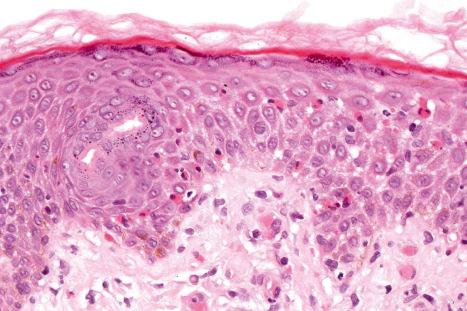
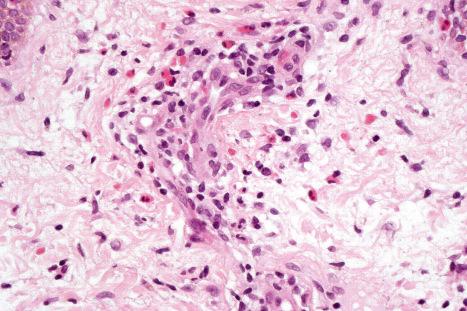
The verrucous plaques and nodules seen occasionally in localized or chronic fogo selvagem show acanthosis, hyperkeratosis, parakeratosis, and papillomatosis. Acantholysis is invariably present.
The hyperpigmentation characteristic of remission is a direct result of pigmentary incontinence.
The histologic findings in the endemic form described in the El Bagre area in Colombia are identical to those of fogo selvagem in active disease. In addition, liquefactive degeneration of the epidermal basal cell layer is observed in a quarter of biopsies. Patients may also have sclerodermoid changes, psoriasiform features, large subcorneal pustules, and hyperkeratosis of palms. By direct immunofluorescence, a positive lupus band test is detected in 40% of patients in addition to IgG deposition on the surface of keratinocytes. Reactive antibodies are of the IgG4 subtype with Dsg1 being the major antigen. Sera from patients also contained additional antibodies against antibasement membrane zone as well as further IgG1 anticell-surface antibodies, which may represent desmoplakin I, envoplakin, and periplakin. Antibodies to pilosebaceous units and surrounding neurovascular structures have also been identified in these patients.
Recently, criteria have been proposed to establish a diagnosis of fogo selvagem as distinct from nonendemic p. foliaceus :
clinical evaluation,
presence of subcorneal acantholysis,
positive direct and indirect immunofluorescence and/or immunoprecipitation or ELISA assays,
confirmatory epidemiological data.
As with p. foliaceus, the histologic features in fogo selvagem may be easily overlooked, and a high index of suspicion is critical to making the diagnosis. The differential diagnosis includes p. foliaceus, p. erythematosus, bullous impetigo, staphylococcal scalded skin syndrome, subcorneal pustular dermatosis, and, in some cases, psoriasis. Careful clinical correlation, immunofluorescence studies, and sometimes bacterial culture are necessary to establish a definitive diagnosis.
Pemphigus herpetiformis (p. herpetiformis, herpetiform pemphigus, acantholytic dermatitis herpetiformis) is a variant of pemphigus which shows clinical features resembling dermatitis herpetiformis with the histology and immunofluorescent findings of pemphigus. It is rare, accounting for only up to 7.3% of cases of pemphigus. The sexes are affected equally, and there is a wide age range varying from newborns to 92 years, although neonatal and pediatric cases are extraordinarily rare.
Patients typically present with intensely pruritic, grouped, erythematous papules and plaques, vesicles, and blisters, sometimes associated with mucous membrane involvement. Urticaria may also be a presenting feature. The Nikolksy sign is variably present. Although lesions are often generalized, there is a tendency for the extensor surfaces of the extremities to be particularly involved. Exceptionally, herpetiform pemphigus may be associated with psoriasis, systemic lupus erythematosus, or with an underlying malignancy including lymphoma, lung, prostate, and esophageal cancer, and angiosarcoma (see paraneoplastic pemphigus). Although in some patients the clinical manifestations remain herpetiform throughout, in others, the features evolve into more typical p. foliaceus, fogo selvagem, and, less commonly, p. vulgaris. Contrariwise, patients with typical p. foliaceus and p. vulgaris may go on to develop a herpetiform eruption. IgA pemphigus may also present with herpetiform lesions. In general, p. herpetiformis has a benign course, with most patients responding well to sulfones or steroids.
Immunofluorescence testing shows IgG in an intercellular pattern characteristic of the pemphigus group of disorders on both direct and indirect techniques. In most patients, Dsg1 (p. foliaceus antigen) is the target autoantigen. However, in some patients, antibodies against Dsg3 (p. vulgaris antigen) have also been documented. A patient has been reported with both IgG as well as IgA antibodies against Dsg1 in addition to anti-Dsc (desmocollin) 3 IgG. Why antibodies to Dsg1 in patients with p. herpetiformis often fail to induce appreciable acantholysis compared with p. foliaceus is uncertain. It is postulated that the p. herpetiformis antibody targets a different epitope although this has yet to be confirmed. Recently, two patients with neutrophil-rich histology were shown to co-localize pemphigus antibody and the neutrophil chemoattractant IL-8. In addition, circulating IgG antibody upregulated cultured keratinocyte IL-8 expression, thereby offering an explanation for the neutrophil recruitment.
The biopsy findings are variable and often non-specific. Although eosinophilic spongiosis is most typical, spongiosis associated with either a mixed eosinophilic and neutrophilic, or a neutrophil-predominant infiltrate may also be encountered. Intraepidermal vesicles and pustules, also of variable composition, are often present, and dermal papillary neutrophil microabscesses have been described. Acantholytic cells are usually (but not invariably) identified. A requirement for multiple biopsies before a diagnosis can be established is a common theme in the literature.
There is both clinical and histologic overlap with IgA pemphigus and dermatitis herpetiformis. Immunofluorescence allows for distinction between these entities. It should also be noted that, exceptionally, dermatitis herpetiformis may histologically show occasional acantholytic cells in the absence of any evidence of pemphigus herpetiformis.
In cases where eosinophilic spongiosis is the predominant histologic feature, the differential diagnosis also includes hypersensitivity reactions and infection (bacterial and fungal). Immunofluorescence studies and special stains for microorganisms will eliminate these possibilities.
P. erythematosus (Senear-Usher syndrome) is a mild localized form of superficial pemphigus with the histologic and immunofluorescent findings of p. foliaceus combined with features of lupus erythematosus. In general, the latter is subclinical, being suggested only by laboratory findings, but there are also rare reports of full-blown systemic disease being present. The condition shows a worldwide distribution and a slight female predominance. Exceptionally, it has been described in children although immunological confirmation of the diagnosis is available in only one case.
Clinically, it is commonly confined to the head, neck, and upper trunk, and typically resembles p. foliaceus. Lesions are erythematous, scaly, and crusted, with or without superficial vesicles, blisters, or erosions. Facial involvement often shows a butterfly distribution reminiscent of lupus erythematosus or seborrheic dermatitis ( Fig. 5.31 ). Mucous membrane involvement is exceedingly rare.
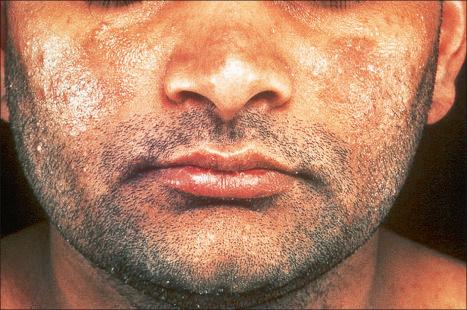
There are reports of p. erythematosus developing after treatment with a number of drugs, notably d -penicillamine, and there are also instances attributed to therapy with propranolol, captopril, pyritinol, thiopronine, ceftazidime, cefuroxime, and atorvastatin. P. erythematosus has also been described as a complication of heroin abuse. In p. foliaceus patients misdiagnosed as having psoriasis, phototherapy can induce p. erythematosus with a positive lupus band test.
P. erythematosus may rarely be associated with thymoma. Typically, the thymoma precedes the onset of cutaneous lesions, which often present following thymectomy. Most tumors have been benign, but one malignant variant has been documented. P. erythematosus may also be a manifestation of paraneoplastic pemphigus.
P. erythematosus, in addition to intercellular staining, also shows granular deposition of IgG and complement along the basement membrane region (positive lupus band test) ( Figs 5.32 and 5.33 ). Typically the latter deposits are found within sun-exposed skin, but in some patients normal, non-sun-exposed skin may also be positive. Pemphigus antibody is generally present on indirect immunofluorescence, and antinuclear factor may also be identified. Anti-DNA antibodies and antibodies to extractable nuclear antigens are negative except in those patients with features of systemic lupus erythematosus. In common with p. foliaceus, the antibody reacts with Dsg1. In p. foliaceus patients, circulating anti-Dsg1 precipitate a cleaved off ectodomain of Dsg1 along the basement membrane. This may account for the positive lupus band test in p. erythematosus.
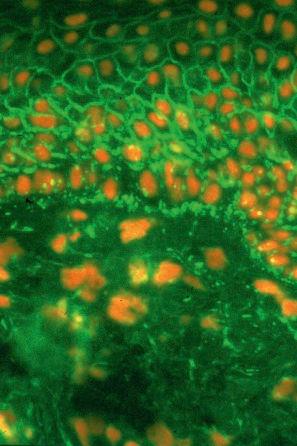
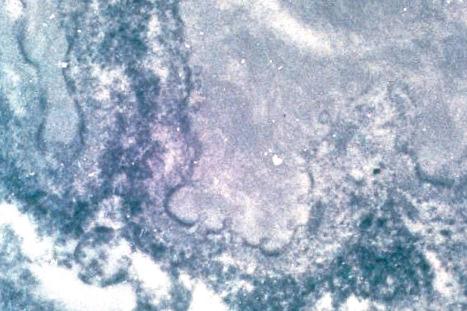
P. erythematosus has histologic changes that are identical to those seen in p. foliaceus and fogo selvagem. As the blisters are superficial, it is often very difficult to obtain an intact lesion for diagnosis. Usually, the cleft or blister lies within the granular layer or beneath the stratum corneum. As with the other forms of superficial pemphigus, acantholysis is frequently difficult to detect, but usually a few acantholytic cells can be found attached to the roof or floor of the blister. The blister may contain numerous acute inflammatory cells, particularly neutrophils, which can make distinction from subcorneal pustular disorders especially difficult.
The differential diagnosis includes the other forms of superficial pemphigus (p. foliaceus and fogo selvagem), bullous impetigo, and staphylococcal scalded skin syndrome, in addition to subcorneal pustular dermatosis. Distinction depends on a careful consideration of the clinical information, the results of bacterial culture, and immunofluorescence studies.
Paraneoplastic pemphigus is a variant of pemphigus, quite distinct from p. vulgaris and p. foliaceus. Paraneoplastic pemphigus may be associated with a variety of tumors, such as B-cell lymphoproliferative disorders and hematopoietic malignancies, Castleman disease, Waldenström macroglobulinemia, thymoma (occasionally with myasthenia gravis), Hodgkin lymphoma, carcinomas (e.g., carcinoma of bronchus, pancreas, liver, uterus, breast, thyroid, and liver), and sarcomas (including dendritic follicular cell sarcoma, round cell liposarcoma, leiomyosarcoma, and inflammatory myofibroblastic tumor). We have seen an exceptional association with systemic mastocytosis. Lymphoma is most often the coexistent neoplasm. In a case of a patient with non-Hodgkin lymphoma, the disease developed only after six cycles of fludarabine, raising the possibility of an association with the medication. Rarely, patients presented with a disease fulfilling the diagnosis of paraneoplastic pemphigus by histology, immunoblotting, and immunoprecipitation but with no underlying neoplasms have been reported.
Paraneoplastic pemphigus has been defined by Sapadin and Anhalt as follows :
painful mucosal erosions and a polymorphous skin eruption in the context of an occult or confirmed neoplasm ( Fig. 5.34 ),
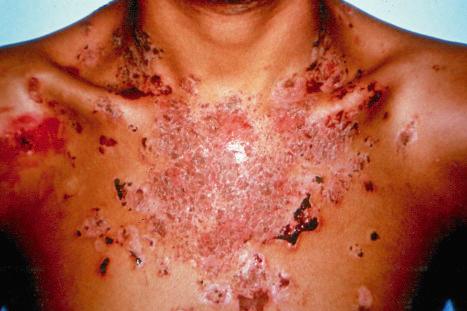
histopathological changes of keratinocyte necrosis, intraepidermal acantholysis, and vacuolar-interface dermatitis,
direct immunofluorescence showing intercellular IgG and complement accompanied by linear or granular complement at the dermal–epidermal junction ( Fig. 5.35 ),
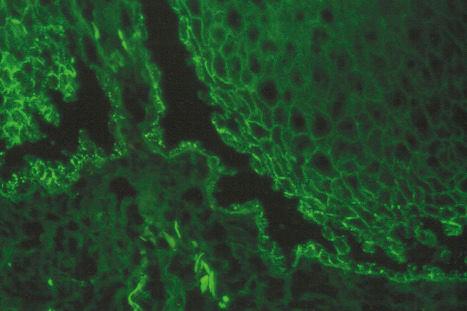
indirect immunofluorescence showing circulating antibodies to simple, columnar, and transitional epithelia in addition to a more typical pemphigus pattern of binding to skin and mucosa,
circulating autoantibodies that immunoprecipitate a high molecular weight complex of polypeptides from keratinocyte extracts weighing 250, 230, 210, 190, and 170 kD.
Although the disease may develop in a wide age range (7–83 years), the majority of patients have been in the fifth to eighth decades, and there is a male predominance. Exceptionally, children may be affected. Lesions are seen in both the mucosa and the skin. Patients present with refractory, painful, persistent erosions of the oral mucosa and vermilion border of the lips. In addition, the tongue, gingiva, floor of mouth, palate, oropharynx, and nasopharynx can be affected. Manifestation confined to the skin or oral mucosa is exceptional. Esophageal disease has been described, and the trachea and bronchi may be affected. The latter may be accompanied by an invariably fatal bronchiolitis obliterans-like disorder in 6–29% of patients. Colonic involvement is unusual. Frequently, patients also have severe pseudomembranous conjunctivitis with symblephara, and eventual blindness may occur. The vulva, vagina, and penis are sometimes affected. Myasthenia gravis may be seen in up to 35% of patients with paraneoplastic pemphigus. Rarely, the disease is accompanied by alopecia areata.
Cutaneous lesions are typically polymorphic and often present as a pruritic papulosquamous dermatosis with subsequent blistering. The trunk, proximal extremities, palms, and soles are characteristically affected. Nail involvement may occur. Although the eruption typically resembles p. vulgaris, it may also mimic p. foliaceus, IgA pemphigus, bullous pemphigoid, linear IgA disease, lichen planus pemphigoides, erythema multiforme, and toxic epidermal necrolysis. P. vegetans-like lesions have been described. Paraneoplastic pemphigus is associated with a very high mortality.
In paraneoplastic pemphigus, circulating antibodies bind to desmosomal and hemidesmosomal plakin family members including 250-kD (desmoplakin I), 230-kD (bullous pemphigoid antigen), 210-kD (desmoplakin II), 210-kD (envoplakin), 190-kD (periplakin), and 170-kD (alpha-2-macroglobulin-like-1, a protease inhibitor) antigens. The presence of antibodies to envoplakin and periplakin (both cornified envelope constituents) is believed to be highly specific for paraneoplastic pemphigus, and the linker domain of plakins may be of particular significance. Antibodies to Dsg1 and 3 are also usually present and plectin (another plakin family member) antibodies may be found. Anti-Dsg antibodies are thought to be of particular importance in the initiation of lesions, disrupting the cell membrane and thereby exposing desmosomal and hemidesmosomal plakin proteins with resultant autoantibody formation.
Direct immunofluorescence shows IgG deposition affecting the whole thickness of the epidermis, whereas C3 is found only on the lower layers. Characteristically, the intercellular staining is often focal and faint. In addition, complement C3 is present along the basement membrane region. Immunoglobulin deposition, specifically anti-epiplakin, in the respiratory epithelium has also been documented. Indirect studies confirm the presence of a circulating antibody although the membrane deposition is often masked by strong cytoplasmic labeling. This latter can be reduced or abolished by serum dilution.
In paraneoplastic pemphigus, in addition to binding to stratified squamous epithelium, the antibody labels transitional epithelium, pseudostratified respiratory epithelium, small and large intestinal mucosa, and thyroid epithelium. It also reacts with myocardium and skeletal muscle. Rat bladder epithelium is said to be highly specific for paraneoplastic pemphigus. Up to 25% of cases, however, are negative.
Recently, there has been accumulating evidence demonstrating considerable heterogeneity within disorders designated as paraneoplastic pemphigus in addition to overlap with other immunobullous diseases. Patients with additional IgA antibodies against Dsg1, Dsg3, desmocollins, envoplakin, periplakin, bullous pemphigoid antigens, type VII collagen, and laminin 332 have been reported. Immunophenotypic variability among paraneoplastic pemphigus patients has thus been established. The documentation of patients displaying p. vulgaris-like or p. foliaceus-like features has led some authors to suggest that immunobullous disorders arising in association with malignancy would be best viewed as representing a spectrum rather than a distinct entity. Included within this spectrum are other nonpemphigus immunobullous disorders resembling erythema multiforme, graft-versus-host disease, and lichen planus. The description of antibodies reactive with desmoplakins I and II in some patients with erythema multiforme raises the possibility that these autoantibodies play a pathogenic role in a subset of patients. However, further study will be necessary to determine the significance of this finding.
Analogous to other forms of pemphigus, recent studies have suggested a genetic predisposition. HLA typing has identified HLA-Cw*14 as the predisposing allele in a Chinese population while DRB1*03 was identified in a French study.
The histologic findings in paraneoplastic pemphigus are highly variable but are characterized by an admixture of suprabasal acantholysis, often resembling p. vulgaris, with cleft or vesicle formation (sometimes involving adnexal epithelium), and interface changes with basal cell liquefactive degeneration, dyskeratotic keratinocytes, and lymphocytic exocytosis ( Figs 5.36–5.38 ). Spongiosis is often present. A perivascular and lichenoid chronic inflammatory cell infiltrate is typically seen in the superficial dermis. In some cases, the histologic features may closely simulate lichen planus. A mixture of histological patterns in different biopsies from the same patient is often seen. Eosinophils, however, are rare. Pigmentary incontinence is frequently evident.
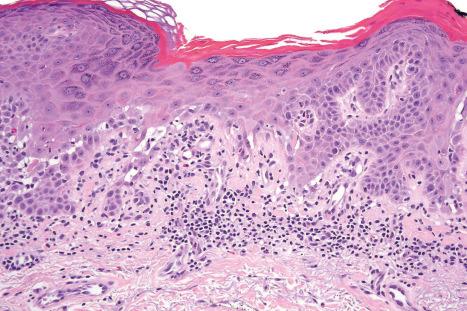
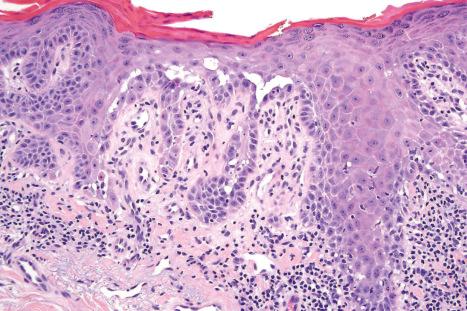
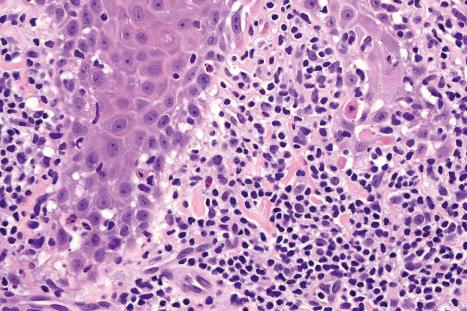
Acantholysis-like change has also been described affecting the bronchial lining epithelium and brochiolitis obliterans-like features may be seen.
The biopsy findings of admixed acantholysis and interface change appear to be relatively non-specific. This contention is demonstrated by skin lesions in patients with typical autoimmune pemphigus without evidence of neoplasia that have histologic features considered typical of paraneoplastic pemphigus.
The differential diagnosis includes mainly interface dermatitides (e.g., drug eruption, lichen planus, erythema multiforme, graft-versus-host disease) rather than other variants of pemphigus. A very high index of suspicion on the part of the pathologist and clinician alike and confirmatory immunofluorescence studies are prerequisites to achieving a correct diagnosis.
IgA pemphigus is a rare dapsone-responsive variant of pemphigus that, as its name suggests, is characterized by intercellular IgA deposition and presents clinically with pustular rather than bullous or vesicular lesions. This disease has been described under a number of different names, such as intraepidermal neutrophilic IgA dermatosis, IgA p. foliaceus, IgA herpetiform pemphigus, intraepidermal IgA pustulosis, intercellular IgA dermatosis, and intercellular IgA vesiculopustular dermatosis. Most patients are middle-aged or elderly, but children may also be affected. The sex incidence is equal. There is no racial or geographic predilection. Drug-induced variants have occasionally been documented.
IgA pemphigus is divided into two major subtypes: subcorneal pustular dermatosis (SPD) variant (IgA p. foliaceus) and intraepidermal neutrophilic IgA dermatosis (IEN) variant (IgA p. vulgaris). Other less readily classifiable variants, termed atypical IgA pemphigus, may also be encountered.
Patients with SPD-like IgA pemphigus present with superficial flaccid pustular lesions, often arising on an erythematous base and typically affecting the trunk and proximal limbs, although the intertriginous sites are predilected. Very uncommonly, there is exclusive involvement of the oral mucosa and perianal skin. Occasionally, there is generalized skin involvement. Lesions are crusted and progress with peripheral extension to form ringlike and rosette patterns. The features may be indistinguishable from classical non-IgA-associated SPD.
Patients with the IEN IgA dermatosis variant present with generalized pustules and crusts and erythematous macules with peripheral vesicles forming the so-called sunflower-like configuration ( Figs 5.39 and 5.40 ). A dermatitis herpetiformis-like presentation with grouped edematous papules may also be encountered.
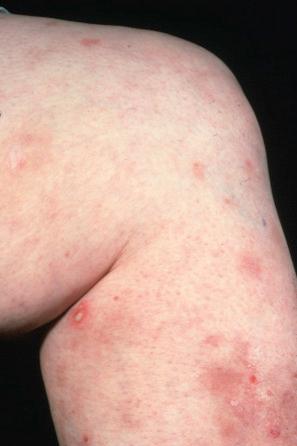
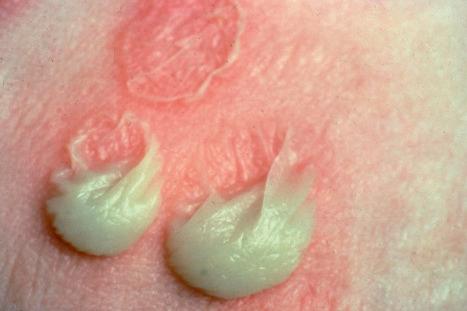
Pruritus is common and is sometimes severe.
The lesions in occasional patients resemble classic p. vulgaris or p. foliaceus. In one childhood case, a p. vegetans-like presentation associated with α1-antitrypsin deficiency was documented. Mucous membrane involvement in either variant is exceptional. Nikolsky sign has been reportedly negative at least in a subset of patients. IgA pemphigus tends to be a chronic relapsing but relatively benign disorder.
A significant number of patients (approximately 20%) may have an associated monoclonal gammopathy, usually of the IgA class. Two documented cases have been benign, and the others have represented B cell lymphoma or multiple myeloma.
SPD IgA pemphigus is characterized by intercellular IgA deposition in the upper epidermis, and circulating IgA antibodies that preferentially bind to the upper epidermis are typically present. In contrast, in the IEN variant, IgA is deposited preferentially in the lower epidermis, and circulating antibodies also generally bind to the lower epidermis. In some patients, however, the IgA antibody binds to the entire thickness of the epithelium. A linear subcorneal distribution has also been documented. Complement is not usually present and IgM is absent. IgG is typically absent, but there are rare cases of atypical pemphigus with both IgG and IgA that likely represent an unusual form of IgA pemphigus. The antibodies are of the IgA1 subclass and are usually of low titer. They have been identified in approximately 50% of patients.
By immunoelectron microscopy performed on a limited number of cases, the immunoglobulin has been identified within the intercellular space, on the keratinocyte cell membrane, in some cases showing desmosomal accentuation. In the SPD type, labeling has been predominantly detected in extracellular spaces between keratinocytes at desmosomes, whereas labeling is mainly in intercellular spaces in nondesmosomal areas in the IEN variant.
The two subtypes result from autoantibody production to different desmosomal proteins. Patients with the SPD variant show reactivity with desmocollin 1. In contrast, anti-Dsg1 or anti-Dsg3 IgA antibodies are present in the IEN variant. One patient with the SPD variant showed both anti-Dsc1 as well as anti-Dsg1 IgA. In some patients, however, neither desmocollins nor desmogleins appear to be involved, suggesting that IgA pemphigus is a heterogeneous group of conditions.
Histologically, in the SPD variant, vesicles are typically found in a subcorneal location associated with a neutrophil infiltrate. It is thought that the presence of IgA is responsible for the striking neutrophil response of this disorder since IgA is associated with neutrophil chemotaxis and neutrophils bear IgA receptors.
In the IEN variant, the pustules can be distributed throughout all layers of the epidermis and may also involve the hair follicles ( Figs 5.41 and 5.42 ). Acantholytic cells are usually (but not always) present. Typically, they are sparse and, as such, this diagnostic clue may be very easily overlooked. Prominent dyskeratotic cells have been described in a rare case of IgG/IgA pemphigus. Significant numbers of eosinophils may also be seen in occasional IEN cases. Neutrophil dermal papillary microabscesses have also been described, sometimes accompanied by neutrophil spongiosis. A perivascular infiltrate of neutrophils, lymphocytes, and histiocytes surrounds the superficial vascular plexus, and eosinophils may also sometimes be present. In addition to the major variants characterized by pustules, some patients with IgA pemphigus show histologic features typical of classic p. vulgaris, p. foliaceus, or even, exceptionally, p. vegetans.
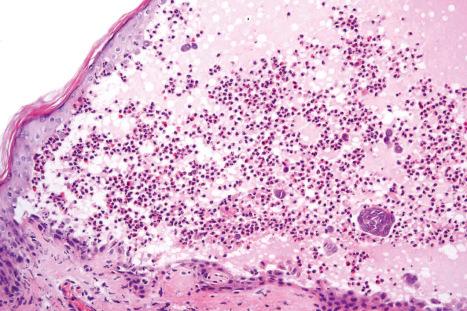
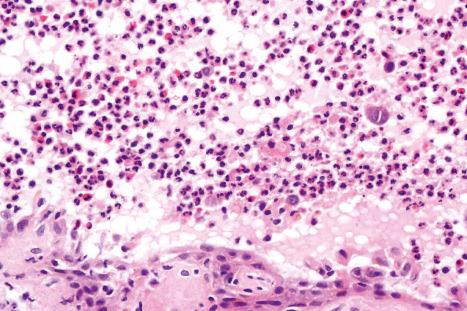
Become a Clinical Tree membership for Full access and enjoy Unlimited articles
If you are a member. Log in here